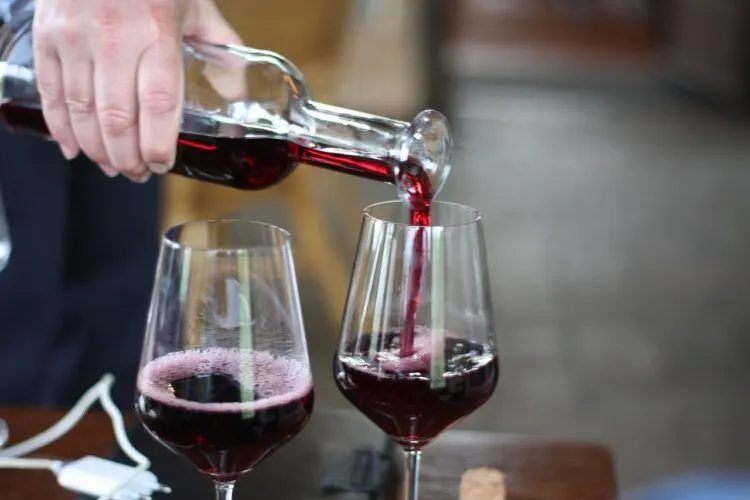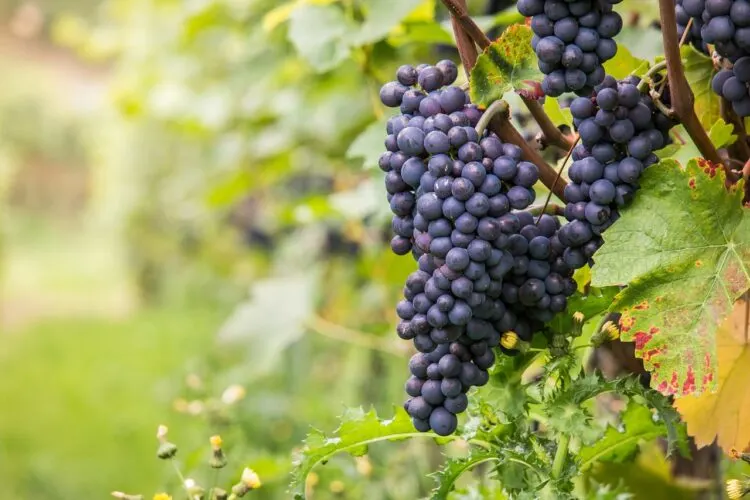When it comes to choosing the perfect red wine, you have sweeter and/or lighter reds, and then you have heavier, heartier reds. So let’s compare the two richest reds: Cabernet Sauvignon vs Malbec.
Cabernet Sauvignon is known for a fuller body than Malbec, with higher tannins, complex notes of black currant, cedar, and spice, and a deeper color. Malbec is medium to full-bodied with notes of blackberry, plum, and vanilla. Cabernet pairs well with red meats, while Malbec pairs well with spicier foods.
Both wines have unique characteristics and flavors that make them popular choices among wine lovers. In this blog post, we will delve into the origins of these two grape varieties, exploring their differences and similarities.
We’ll discuss how each wine’s taste profile is influenced by factors such as sweetness or dryness and alcohol content. Furthermore, we’ll take a look at the hue and body of both wine types, in addition to how they evolve over time.
Lastly, we’ll compare the average price points for Cabernet Sauvignon and Malbec wines and provide expert recommendations on food pairings to enhance your dining experience with these exquisite reds. By understanding these nuances in greater detail, you can make an informed decision when selecting your next bottle of fine wine.

Introduction to Malbec and Cabernet Sauvignon
Cabernet Sauvignon and Malbec are two well-known red wines that originate from different parts of the world. The Cabernet Sauvignon grape is primarily grown in the Bordeaux region of France, but it has also gained popularity in other regions such as Napa Valley, Washington State, South Africa, and New Zealand.
The Malbec grape, on the other hand, was initially cultivated in Southwest France. However, it truly flourished when introduced to Argentina in the 17th century. Today, Argentine Malbecs dominate global production with their bold flavors and smooth texture.
- Napa Valley: Known for its high-quality Cabernet Sauvignons with rich fruit flavors and firm tannins.
- Bordeaux: Home to both Cabernet Franc (parent grape of Cab) and classic French Malbecs known for their higher acidity compared to Argentine counterparts.
- New Zealand: Produces excellent examples of both varietals due to its diverse terroir; Hawke’s Bay is particularly famous for producing outstanding Cabs while Central Otago excels at growing top-notch Malbec grapes.
- South Africa: Stellenbosch region boasts some exceptional cabernets displaying notes of blackcurrant alongside moderate tannins while Swartland offers unique expressions of malbec showcasing dark fruit flavors combined with a smoky finish.
- Washington State: A rising star in the world of wine, producing bold Cabernet Sauvignons and increasingly popular Malbecs that exhibit dark fruit flavors with a touch of spice.
Malbec Basics: Silky and Seductive
Malbec is a full-bodied red wine primarily known for its plush, fruity flavors and smooth texture.
Originating from France, it’s now most famously produced in Argentina, which has become synonymous with high-quality Malbec. The wine is typically characterized by deep red or purple color, high tannin levels, and a medium to high acidity. Its flavor profile often includes robust notes of blackberry, plum, and black cherry, accompanied by subtler hints of cocoa, leather, and tobacco, especially in aged bottles.
In terms of alcohol content, Malbec wines usually range between 13-15% ABV.
The grapes thrive in warmer, sunnier climates, which contributes to their ripe, concentrated fruit flavors. Argentine Malbecs, in particular, are known for their bright, fruit-forward profile, developed in the unique terroir of regions like Mendoza. These wines are often less tannic compared to their French counterparts, making them accessible and enjoyable to a wide range of wine enthusiasts.
Malbec pairs exceptionally well with red meats, robust cheeses, and hearty stews, making it a popular choice for barbecues and meat-centric cuisines. Its versatility and approachability have contributed to its growing popularity in the global wine market. Malbec is an excellent choice for those seeking a rich, flavorful red wine with a balanced complexity.

Cabernet Sauvignon Basics: A Bold Classic
Cabernet Sauvignon, renowned for its depth and complexity, is one of the world’s most widely recognized red wine grape varieties.
Originating from the Bordeaux region of France, it is now extensively cultivated in wine regions across the globe, including Napa Valley in California, Chile, and Australia. The grape is known for its thick skin and high tannin content, which contribute to the wine’s notable structure and aging potential. Cabernet Sauvignon typically exhibits a deep ruby color and a full-bodied profile.
The wine’s flavor palette is characterized by rich, concentrated notes of black currant, dark cherries, and plums, often complemented by hints of cedar, tobacco, and oak, especially when aged in barrels. The oak aging process imparts additional flavors like vanilla and spices, adding to its complexity.
With an alcohol content generally ranging from 13.5% to 15%, Cabernet Sauvignon is robust yet balanced.
Cabernet Sauvignon pairs exceptionally well with hearty meat dishes like steak and lamb, as well as aged cheeses, making it a favorite choice for fine dining and special occasions.
Its widespread cultivation and popularity stem from its consistent quality and the ability to express the unique characteristics of its terroir, making each region’s Cabernet Sauvignon distinct. This versatility and richness make Cabernet Sauvignon a celebrated choice among red wine enthusiasts.
Grape Varietals and Wine Colors
The color and body of a wine can greatly impact its overall appeal, as well as provide hints about its flavor profile. When it comes to Malbec and Cabernet Sauvignon, both are considered full-bodied wines with distinct hues that set them apart from other reds.
Malbecs tend to have a deep, dark color and body compared to Cabernet Sauvignon which is often more light-bodied. When it comes to aging potential, the two wines can vary significantly depending on their individual characteristics.
Key Information About Malbec
Malbec, originating in France but now predominantly produced in Argentina, boasts a deep purple color with dark red undertones. This rich hue is reflective of the bold flavors often found within Malbec wines, such as blackberry, plum, and notes of spice like black pepper or even milk chocolate.
Key Information About Cabernet Sauvignon
In contrast, Cabernet Sauvignon – one of the most popular grape varieties worldwide – presents itself with an intense dark red color reminiscent of the dark fruits it embodies.
By understanding the differences in color and body between these two well-known red wines, you’ll be better equipped to choose the perfect wine for your next meal or gathering.
Taste and Flavor Profile
Cabernet Sauvignon, a full-bodied wine originating from the Bordeaux region of France, has high tannins with notes of black currant, cedarwood, and green bell pepper. In contrast, Malbec, native to Southwest France but now predominantly produced in Argentina, offers moderate tannins with flavors of blackberry jam and milk chocolate.

What Does Malbec Taste Like?
Malbec is a popular red wine known for its rich, dark fruit flavors and smooth finish. It typically presents a robust and full-bodied profile, making it a favorite among red wine enthusiasts. The primary flavors of Malbec include:
- Dark Fruit Notes: Malbec is renowned for its deep, juicy flavors of blackberry, plum, and black cherry. These dark fruit notes are the cornerstone of its flavor profile, offering a luscious and ripe taste that is both inviting and warming.
- Earthy Undertones: Beyond its fruitiness, Malbec often reveals subtle earthy undertones. Hints of leather, tobacco, and a touch of herbal notes can be detected, adding complexity and depth to the wine.
- Spice and Oak: Many Malbec wines undergo oak aging, which imparts additional layers of flavor. This process contributes nuances of vanilla, cocoa, and a mild spicy kick, typically reminiscent of black pepper or cinnamon, enhancing the overall sensory experience.
Malbec’s balanced acidity and moderate tannins make it quite approachable. Its alluring combination of bold fruit, subtle earthiness, and a hint of spice creates a harmonious and indulgent palate experience. The wine’s flavor intensity and richness make it particularly well-suited for pairing with grilled meats, spicy dishes, and robust cheeses.
What Does Cabernet Sauvignon Taste Like?
Originating from the Bordeaux region in France but now grown across various regions including Napa Valley and Washington State, this iconic variety offers complex flavors ranging from black cherry to cassis along with firm tannins that contribute to its full body.
- Maintain room temperature: To best appreciate these two varietals’ unique colors and bodies when enjoying at home or during a tasting event at your local grocery store or wine shop,
- Pour into proper glassware: Make sure you serve them at room temperature (around 60°F) using appropriate glassware designed for full-bodied red wines,
- Aerate if necessary: And don’t hesitate to aerate or decant if needed, as this can help enhance the flavors and textures of both Malbec and Cabernet Sauvignon.
Are Cabernet Sauvignon and Malbec Similar?
Cabernet Sauvignon and Malbec, while both popular red wines, exhibit distinct characteristics that set them apart. They share some similarities, such as their deep red color and ability to pair well with red meats, but their flavor profiles, tannin levels, and origins differ significantly.
Cabernet Sauvignon, originating from Bordeaux, France, is known for its high tannin content and aging potential.
Its flavor is characterized by a more pronounced acidity and robust notes of dark fruits like blackcurrant, along with earthy and woody undertones, often complemented by aging in oak barrels. This process imparts flavors of vanilla, cedar, and spice, contributing to its complexity.
Cabernet Sauvignon’s full-bodied nature and higher tannins make it a wine that can age well, developing more nuanced flavors over time.
Malbec, primarily associated with Argentina, though originally from France, presents a fruitier and plusher profile with a lower tannin level compared to Cabernet Sauvignon. It is recognized for its juicy flavors of blackberry, plum, and black cherry, combined with a smoother and less acidic finish.
Malbec often displays subtler notes of cocoa, leather, and a mild spicy quality. It’s generally considered more approachable in its youth than the often more austere Cabernet Sauvignon.

What Is the Difference Between Cabernet Sauvignon and Malbec?
Cabernet Sauvignon and Malbec, though both red wines have distinct differences that set them apart, especially in their winemaking process, regional variations, and typical flavor nuances.
Cabernet Sauvignon grapes have a thicker skin, leading to wines with deeper color and longevity. This grape variety is often blended with others to balance its strong tannins and acidity. In terms of regional variation, Napa Valley Cabernets are known for their richer, more fruit-forward style compared to the more structured and earthy Cabernets of Bordeaux.
Malbec, primarily thriving in Argentina, shows a different expression than its French counterpart. Argentine Malbecs are recognized for their ripe, plush flavors due to the warm, high-altitude regions they are grown in. This results in a wine that is less tannic and more fruit-driven, often with a velvety texture.
Regarding flavor nuances, Cabernet Sauvignon typically exhibits flavors of blackcurrant, cedar, and sometimes green bell pepper, reflecting its pyrazine compounds. Malbec, in contrast, is known for its plummy flavor and softer tannins, with a subtler, less astringent profile than Cabernet Sauvignon.
In essence, while both wines share the characteristic of being bold reds, Cabernet Sauvignon leans towards a more tannic, structured profile with potential for aging and blending, whereas Malbec offers a fruitier, more immediately approachable taste with a focus on varietal purity.
Are Cabernet Sauvignon and Malbec Wines Sweet or Dry?
When it comes to the sugariness of these two renowned red wines, there are some noteworthy distinctions between them. Malbec, despite being a dry wine, has a surprisingly jammy flavor that makes it taste sweeter than you might expect.
This allows its moderate tannins and low acidity to shine without drying out your mouth, giving Malbec a juicy mouthfeel.
In contrast, Cabernet Sauvignon is much drier in comparison. Its high tannin content gives it a dry, gritty texture that helps the dark fruit flavors stick to your palate. With no residual sugar present in most Cabernets compared to around 1.5g per liter found in Malbecs, this can make Cabernet Sauvignons taste chalkier.
Confused about the types of wine and how they differ and how they are similar?
Click that link to read my article on that topic and also to see a handy chart that breaks down all the major types of wine into a convenient, easy-to-read chart that makes it easy to know what to buy.
Sweetness Factors:
- Moderate Tannins & Low Acidity: Gives Malbec its sweet-like taste despite being classified as a dry wine.
- Jammy Flavors: Adds an unexpected touch of sweetness to Malbec’s overall profile.
- No Residual Sugar vs Some Residual Sugar: Cabernet Sauvignons typically have no residual sugar while Malbecs contain about 1.5g per liter on average – making them seem slightly sweeter by comparison.
The next time you’re deciding between these two delicious wines at the grocery store or during dinner with friends, consider their distinct characteristics when choosing which one will best suit your preferences and food pairings.
Cabernet Sauvignon and Malbec wines can vary in sweetness, depending on the producer. It is essential to examine the alcoholic strength of Cabernet Sauvignon and Malbec wines when attempting to comprehend them more thoroughly.
Aging of the Wine
Cabernet Sauvignon vs. Malbec Winemaking
Cabernet Sauvignon is known for its exceptional aging potential, thanks to its high tannin levels. As these tannic wines age, they become more velvety and complex in flavor. This makes them an excellent choice for wine enthusiasts who enjoy discovering the subtle nuances that develop over time.
In contrast, Malbec also ages well but has a slightly shorter optimal aging period due to its softer tannins. Generally speaking, a good-quality Malbec will drink well after 5 years of aging. However, some higher-end bottles can benefit from longer cellaring periods resulting in an even greater depth of flavor.
- Cabernet Sauvignon: High tannin levels make it ideal for long-term aging; flavors become more velvety and complex over time.
- Malbec: Softer tannins result in a shorter optimal aging period; still develop complexity with age but typically peak around 5 years.
To get the most out of your aged wines, it’s essential to store them properly.
Both Cabernet Sauvignon and Malbec should be kept at a consistent temperature (around 55°F) with moderate humidity levels (50-70%). Additionally, ensure that your wine is stored away from direct sunlight or other sources of heat that could negatively impact the quality as it matures (source).
By following these guidelines, you’ll have an enjoyable experience when it’s time to uncork your aged Cabernet Sauvignon or Malbec.
Malbec and Cabernet Sauvignon both have the potential to develop pleasingly over time, yet their aging processes can be distinct in certain ways. As such, it is important to consider how the average price of these two wines compares when making a purchasing decision.
Food and Wine Pairings
- Cabernet Sauvignon pairings:
- Fatty meats (prime rib, ribeye)
- Garlic-herb dishes (French/Italian cuisine)
- Pasta dishes
- Malbec pairings:
- Game birds (quail, pheasant)
- Lean meats (venison, hanger steak)
- Salty cheeses (blue cheese, aged cheddar)
When it comes to selecting a wine for your meal, take into account individual preferences and be open to discovering the ideal combination. Don’t be timid to try different combinations and discover the ideal blend for your palate.

Cabernet Sauvignon Food Pairings
The acidity of Cabernet Sauvignon makes it an excellent choice for pairing with rich, fatty meats. Pairing Cabernet Sauvignon with food can include prime rib, steak, beef roast, and lamb roast for their full-bodied flavors that harmonize well with the tannins and acidity of the wine. The bold flavors in these dishes are complemented by the wine’s tannins and acidity.
In addition to meat-based dishes, Cabernet Sauvignon also pairs beautifully with garlic and herbs.
This compatibility brings out the best in French and Italian cuisine as well as carb-heavy meals like pasta. For more food pairing ideas specifically tailored to Cabernet Sauvignon wines, check out our dedicated guide.
Malbec Food Pairings
Malbec, on the other hand, is better suited for game birds and lean meats such as venison or hanger steak due to its moderate tannins and fruity flavor profile. Salty cheeses like blue cheese or aged cheddar make great accompaniments too.
Serving Temperatures for Cabernet Sauvignon and Malbec
The ideal serving temperature for Cabernet Sauvignon is slightly below room temperature, around 60-65°F (15-18°C).
This temperature range allows the wine’s complex flavors and aromas to fully develop without being muted by excessive cold or altered by warmth. Cabernet Sauvignon benefits from decanting, especially younger or more tannic bottles. Decanting for at least 30 minutes to an hour before serving helps aerate the wine, softening the tannins and enhancing the overall flavor profile.
Malbec, on the other hand, is best served a touch cooler, between 55-60°F (13-15°C).
This slightly cooler temperature is ideal for highlighting Malbec’s rich fruit flavors and balancing its natural acidity and tannins. Like Cabernet Sauvignon, Malbec can also benefit from decanting. For younger and more robust Malbecs, decanting for about 30 minutes helps to open up the wine, while older or more delicate vintages might require less time.
Both wines should not be served too warm, as higher temperatures can make the alcohol more pronounced and overpower the subtler flavors. Conversely, serving these wines too cold can mask their complexities and make them appear overly tannic.
Using a wine thermometer can ensure precision, but a general guideline is to take the wine out of a standard room-temperature environment and cool it in a refrigerator for about 30 minutes before serving.
In summary, Cabernet Sauvignon thrives at a slightly warmer temperature of 60-65°F with aeration through decanting, while Malbec is best enjoyed slightly cooler at 55-60°F, also benefiting from some decanting to allow the wine to express its full range of flavors.
What is the Alcohol Content of Malbec and Cabernet Sauvignon?
Both Malbec and Cabernet Sauvignon boast an ABV on the upper end of the scale, making them two of the more potent varieties apart from port. These popular red wines typically have an alcohol by volume (ABV) range of 13.5 to 15 percent, making them some of the strongest options aside from port wines. They share a similar ABV with other robust varieties such as Californian Pinot Noir, Zinfandel, and Petite Sirah.
The reason behind their high alcohol content lies in the grape-growing regions’ climate conditions. Warmer climates tend to produce sweeter grapes, which subsequently leads to more sugar during fermentation – ultimately resulting in a higher alcohol percentage. Some well-known wine-producing regions for these varietals include:
- Napa Valley, California: Known for its exceptional Cabernet Sauvignons.
- Argentina: Renowned for producing outstanding Malbecs.
- Washington State: Offers excellent examples of both Cabernet Sauvignon and Malbec wines.
- New Zealand: Produces quality Bordeaux-style blends that often feature both grape varieties.
It’s important to keep in mind that while enjoying these full-bodied reds, moderation is key due to their higher alcohol content. Sipping responsibly enables you to experience the robust flavors and intricate nuances of Malbec and Cabernet Sauvignon wines.
Malbec and Cabernet Sauvignon both have an alcohol content of around 13-15%, but there are other differences between the two wines that should be considered. Shifting the focus to the distinction between their hues and consistencies, let’s investigate what makes them one-of-a-kind.

Wine Price Ranges
When it comes to price, there is a noticeable difference between Malbec and Cabernet Sauvignon.
- Affordable Malbec options: Look for wines from Mendoza or Salta regions in Argentina. Brands like Alamos Seleccion ($17) and Catena ($24) offer great value.
- Budget-friendly Cabernet Sauvignons: Seek out lesser-known regions like Chile’s Maipo Valley or South Africa’s Stellenbosch area where quality Cabs can be found at reasonable prices (e.g., Concha y Toro Marques de Casa Concha – around $22).
If you’re interested in exploring these two popular red wines without breaking the bank, consider trying different brands from various parts of the world. By doing so, you’ll not only expand your palate but also discover some hidden gems that won’t hurt your wallet.
Of course, in either case, if you buy it at Trader Joe’s, the wine will be dirt cheap!
But why are Trader Joe’s wines so cheap? Are they inferior? Click that link to read the whole story in another article on my website where I break down the whole truth about Trader Joe’s wine prices.
Which Is More Expensive, Cabernet Sauvignon or Malbec?
Cabernet Sauvignon is generally more expensive than Malbec.
The higher cost is attributed to Cabernet Sauvignon’s prominence, aging potential, and popularity in prestigious wine regions. For a low-priced bottle, Malbec averages around $10 to $15, while Cabernet Sauvignon starts at about $15 to $20. In the mid-range, Malbec typically costs between $20 to $30 per bottle, whereas Cabernet Sauvignon ranges from $30 to $50.
At the high end, premium Malbecs can be found for $50 to $75, but top-tier Cabernet Sauvignons often exceed $100, with some exceptional bottles costing several hundred dollars.
This price difference reflects Cabernet Sauvignon’s status in the wine world and its association with luxury and prestige.
Cabernet Sauvignon Cost
While you can find good bottles of cab for under $20, many high-quality Cabs are priced higher than that, fetching upwards of $50 or more. This can be attributed to factors such as production costs, grape variety scarcity, and regional demand.
Malbec Wine Cost
Malbec is generally more affordable, with many excellent bottles in the $15-$30 range.
The lower price point makes this varietal an attractive option for both casual drinkers and wine enthusiasts alike. Some reasons behind its affordability include increased production in recent years – particularly in Argentina – and less expensive land prices compared to regions like Napa Valley.
Conclusion
After learning about the differences and similarities between Cabernet Sauvignon and Malbec wines, it’s clear that these two varietals offer unique experiences for wine lovers. While both are dry red wines with high alcohol content, their origins, flavor profiles, aging potential, and price points differ significantly.
If you’re looking to pair a bold red wine with a hearty meal of spaghetti or enjoy a glass on its own, consider trying both Cabernet Sauvignon and Malbec to see which one suits your palate best. And next time you visit your local grocery store or wine shop, impress the staff by asking for recommendations based on what you’ve learned about these two popular varietals.
FAQs
How does Malbec compare to Cabernet?
Malbec is generally fruitier and softer in tannins compared to Cabernet Sauvignon, which tends to have more structure and complexity. Malbec often exhibits flavors of plum, black cherry, and spice while Cabernet Sauvignon showcases notes of blackcurrant, cedar, and green bell pepper. Both wines are full-bodied with good aging potential.
What is the earthiest red wine?
The earthiest red wines are usually those from Old World regions, such as Burgundy (Pinot Noir) or Barolo (Nebbiolo). These wines tend to exhibit strong terroir characteristics like forest floor, mushroom, truffle, or wet leaves along with their fruit profiles.
Is Cabernet Sauvignon lighter than Malbec?
No, generally speaking, Cabernet Sauvignon has a fuller body compared to most Malbecs due to its higher tannin content providing more structure. However, individual expressions may vary depending on factors such as regionality or winemaking techniques employed by producers.
- Crescent Roll Origins: Which Country Created It? - February 21, 2024
- What is the Origin of the Name Crescent Rolls? - February 21, 2024
- Are Pillsbury Crescent Rolls a Good Substitute for Puff Pastry? - February 21, 2024
